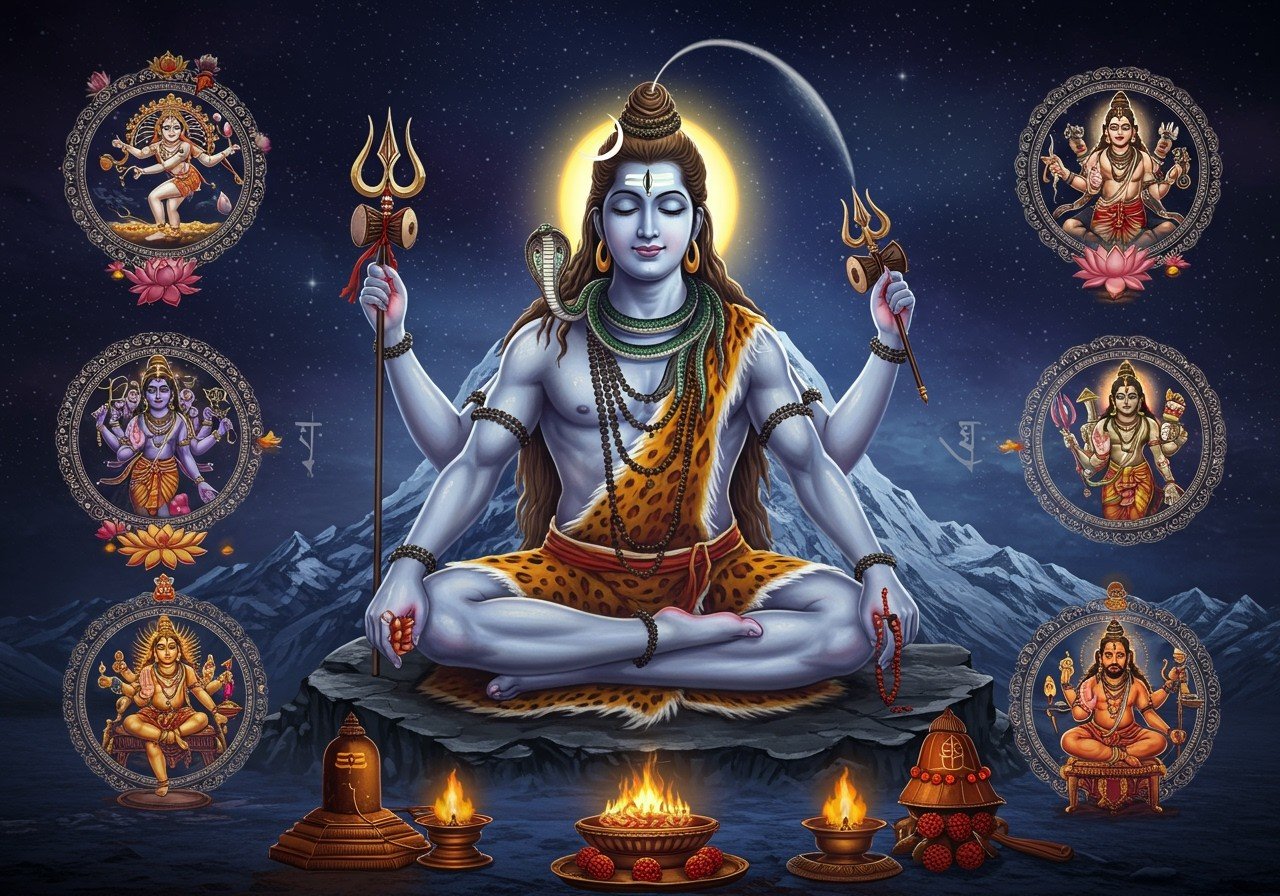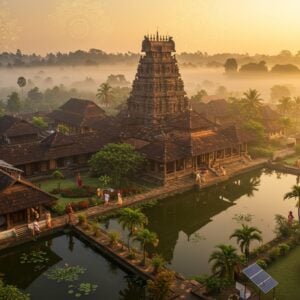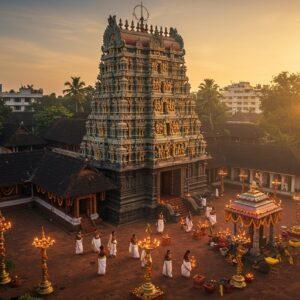
Shiva temples form an integral part of India’s spiritual and cultural fabric. These sacred spaces echo the profound reverence for Lord Shiva, a deity symbolizing the cyclical nature of life, death, and rebirth. For many Indians, a visit to these temples is more than just a ritual; it’s a way to connect with their heritage, community, and the divine. Each temple offers a unique narrative, a spiritual encounter rooted in ancient traditions and beliefs.
Legends of Shiva and Parvati: Whispers from the Temples
The tales of Shiva and Parvati are woven into the very essence of many temples across India. At the Triyuginarayan Temple in Uttarakhand, the divine union of Shiva and Parvati is eternally celebrated by a flame that has burned since their wedding. Kedarnath holds the legend of Shiva taking the form of a bull to evade the Pandavas, leaving his hump behind as an object of veneration. The Amarnath Temple whispers the secrets of immortality revealed by Shiva to Parvati, while the Kamakhya Temple in Assam resonates with the echoes of Shiva’s cosmic dance of destruction. The magnificent Kailash Temple at Ellora, carved from a single rock, stands as a testament to their celestial abode. These narratives enrich the spiritual aura of each temple, deepening the devotee’s connection with their faith.
India’s Famous Shiva Temples: Beacons of Devotion
India’s landscape is graced with magnificent Shiva temples, each possessing unique historical and spiritual significance. These sacred sites stand as testaments to India’s rich cultural heritage and unwavering devotion.
Jyotirlinga Temples: The Twelve Sacred Abodes
Among the most revered Shiva temples are the twelve Jyotirlingas, considered the holiest abodes of Lord Shiva. Each Jyotirlinga signifies a distinct manifestation of Shiva, and devotees believe that visiting these sites bestows blessings and spiritual liberation. Let’s explore some of these divine destinations:
- Kashi Vishwanath Temple, Varanasi, Uttar Pradesh: Situated on the banks of the sacred Ganga, this temple is believed to grant moksha, liberation from the cycle of rebirth. Its spiritual energy is palpable, drawing pilgrims from all walks of life seeking solace and blessings.
- Somnath Temple, Veraval, Gujarat: This historic temple has been destroyed and rebuilt multiple times, a testament to its enduring significance in Hindu faith. It stands as a symbol of resilience and the unwavering devotion of its followers.
- Kedarnath Temple, Uttarakhand: Nestled high in the Himalayas, this temple is a vital part of the Chardham Yatra, a pilgrimage of immense spiritual importance. The challenging journey is said to cleanse the soul and bring one closer to the divine.
- Mahakaleshwar Jyotirlinga, Ujjain, Madhya Pradesh: Located by the serene Rudra Sagar Lake, this temple houses a lingam believed to be self-manifested and radiating divine power. The atmosphere is charged with spiritual energy, captivating all who visit.
- Omkareshwar Mahadev Temple, Shivapuri, Madhya Pradesh: Situated on an island in the Narmada River, this Jyotirlinga holds a special place in the hearts of devotees. Its unique location adds to its mystique and spiritual significance.
- Trimbakeshwar Shiva Temple, Nasik, Maharashtra: Famous for its unique three-faced Shiva Linga, this temple is a significant pilgrimage site, drawing devotees seeking blessings and spiritual renewal.
- Mallikarjuna Swamy Temple, Srisailam, Andhra Pradesh: This temple is not just a Jyotirlinga but also a Shakti Peeth, a place of power dedicated to Goddess Parvati. This dual significance makes it a particularly sacred destination for devotees.
- Baidyanath Dham, Deoghar, Jharkhand: Revered as one of the twelve Jyotirlingas, this temple holds immense spiritual significance for devotees, who come to seek blessings and offer prayers.
- Grishneshwar Temple, Maharashtra: This Jyotirlinga temple is known for its serene atmosphere and spiritual significance. It is a place where devotees can find peace and connect with the divine.
- Nageshwar Jyotirlinga Temple, Jamnagar, Gujarat: Featuring a towering statue of Lord Shiva, this temple is a must-visit for those on the Jyotirlinga pilgrimage. The grandeur of the statue inspires awe and reverence.
- Bhimashankar Temple, Pune, Maharashtra: Located in the picturesque Sahyadri Hills, this Jyotirlinga temple offers both spiritual solace and scenic beauty. It’s a place to connect with nature and the divine.
Other Notable Shiva Temples: Architectural and Spiritual Marvels
Beyond the Jyotirlingas, India is blessed with numerous other Shiva temples, each a unique blend of architectural brilliance and spiritual significance.
- Brihadeeswarar Temple, Thanjavur, Tamil Nadu: This UNESCO World Heritage Site showcases the grandeur of Chola architecture. Its towering vimana and intricate carvings are a testament to the skill and devotion of its creators. Explore more about temple architecture here.
- Ramanathaswamy Temple, Rameswaram, Tamil Nadu: Known for its stunning corridors and serene location on Rameswaram island, this temple is a place of pilgrimage and architectural beauty. Its intricate carvings and vast courtyards evoke a sense of peace and wonder.
- Lingaraj Temple, Bhubaneswar, Odisha: This architectural marvel is dedicated to Harihara, a combined form of Shiva and Vishnu. It represents the harmony between different aspects of the divine and is a testament to the rich spiritual traditions of Odisha.
- Shore Temple, Mahabalipuram, Tamil Nadu: Perched on the shores of the Bay of Bengal, this temple is a beautiful example of South Indian architecture. Its unique location and intricate carvings make it a truly special place to visit. Discover more about coastal temples and their significance.
- Panch Kedar Temples, Uttarakhand: This group of five temples, including Kedarnath, is deeply revered by Shiva devotees. Each temple holds a unique legend and offers a distinct spiritual experience.
- Tarkeshwar Temple, West Bengal: Known for its self-manifested Shiva Linga, this temple draws pilgrims seeking blessings and connection with the divine. The temple’s serene atmosphere enhances the spiritual experience.
- Amarnath Temple, Jammu and Kashmir: Famous for the Amarnath Yatra, this temple’s naturally formed ice lingam is a unique and awe-inspiring sight. The challenging pilgrimage is considered a deeply spiritual experience.
Poojn.in: Your Companion for Shiva Temple Worship
Poojn.in offers a wide selection of authentic puja items for Shiva worship, both at home and in temples. We understand the importance of maintaining sacred traditions and offer high-quality products to support your devotion.
For your Shiva temple visits and home worship, consider these items from poojn.in:
- Pure Copper Kalash and Panchamrit Vessels: Find beautifully crafted copper items here.
- Traditional Bell Metal Diyas and Arti Thalis: Explore our collection of diyas and thalis.Enhance your puja experience with these traditional items.
- High-Quality Rudraksha Malas: Browse our diverse range of rudraksha malas. Choose from various mukhi options to find the perfect mala for your practice.
- Pure Silver Items for Abhishek: Perform abhishek rituals with reverence using our pure silver items.
- Authentic Bilva Leaves and Dhoop: Elevate your worship with authentic bilva leaves and fragrant dhoop.
- Sacred Thread and Moli for Shiva Rituals: Ensure the purity of your rituals with our sacred thread and moli.
- Brass and Copper Nandi Sculptures: Adorn your puja space with beautifully crafted Nandi sculptures.
- Traditional Puja Thalis with Shiva Symbols: Discover our intricately designed puja thalis.Offer your prayers with devotion on these specially designed thalis.
All our products come with quality assurance and secure packaging. We offer pan-India delivery, ensuring the respectful handling of all sacred items. Special discounts are available for bulk orders for temples. Visit poojn.in today to explore our complete collection and experience the convenience of online shopping for all your puja needs.
Embracing the Spiritual Path: Connecting with the Divine
Visiting Shiva temples is a pilgrimage, a journey through history, culture, and deep devotion. Each temple whispers ancient stories and offers profound lessons, connecting us to the divine and our heritage. These sacred places provide spiritual solace and deepen our understanding of India’s vibrant traditions. Embrace the opportunity to visit these revered sites, honor your roots, and experience the transformative power of faith. With every step, we draw closer to the divine and strengthen our bond with the eternal spirit of Shiva.
FAQs: Understanding Shiva Temples and Deities
What is the significance of the Shivling? The Shivling, a symbol of Lord Shiva, represents divine energy and the cosmic pillar of creation. It serves as the focal point of worship in Shiva temples.
Why is Nandi important? Nandi, the bull, is Lord Shiva’s loyal vehicle and gatekeeper. Positioned at the entrance of Shiva temples, Nandi embodies devotion, strength, and unwavering faithfulness.
Are there stories of Shiva and Parvati connected to temples? Yes, numerous Shiva temples are adorned with tales of Shiva and Parvati, narrating their divine love, devotion, and the cosmic dance of creation and destruction. These stories enhance the spiritual significance of each temple.
Which Shiva temples are particularly popular in India? Kedarnath, Somnath, and Kashi Vishwanath are among the most famous Shiva temples, attracting devotees from across the globe with their historical and religious importance.
How are festivals dedicated to Shiva celebrated in temples? Shiva temples come alive during festivals like Maha Shivaratri, observing special rituals, prayers, and offerings. Devotees participate in night-long vigils, fasting, and chanting, immersing themselves in devotion.
Is there a specific dress code for visiting Shiva temples? Visitors are encouraged to dress modestly and respectfully, often in traditional attire, when entering Shiva temples. This demonstrates reverence for the sacredness of the space and the deities within.
What is the role of priests in Shiva temples? Priests play a crucial role in maintaining the sanctity of Shiva temples. They perform rituals, conduct prayers, guide devotees in worship, and share knowledge about the deities and their significance. They act as a bridge between the devotees and the divine.


